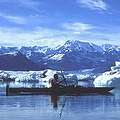 根據最近一份研究冰河和冰帽的報告,海平面在本世紀上升幅度恐超出先前預測,威脅全球沿海上億居民的安全。研究人員表示,不久之後,融化的冰河和冰帽將取代格陵蘭島和南極冰棚,成為海平面上升的主要因素。
根據最近一份研究冰河和冰帽的報告,海平面在本世紀上升幅度恐超出先前預測,威脅全球沿海上億居民的安全。研究人員表示,不久之後,融化的冰河和冰帽將取代格陵蘭島和南極冰棚,成為海平面上升的主要因素。
來自科羅拉多大學波德分校的極地和高山研究所(INSTAAR),和俄羅斯科學院的科學家共同發表這份報告,研究指出,目前60%的融冰來自冰河和冰帽,而過去10年融化速度已快速攀升。
「目前普遍認為格陵蘭島和南極冰棚將是海平面上升的主因,」主要作者、前INSTAAR主任、現科大榮譽教授梅爾(Mark Meier)博士表示,「我們的研究顯示,冰河和冰帽才是未來幾個世代影響海平面的的關鍵角色。」
另一位作者安德森(Rober Anderson)認為,「阿拉斯加的哥倫比亞冰河目前以每年兩立方英里的融化速度流入威廉王子灣,就是一個很好的證據。」哥倫比亞冰河從1980年至今已瘦身9英里,某些地方薄到只剩1300英尺,估計未來20年還會再減少9英里。
研究團隊預估,加速融化的冰河和冰帽將使全球海平面在2100年之前上升4到9.5英寸,這還不包括海水暖化所造成的影響,因此總上升量恐將比估計數字高兩倍。
海平面每上升1英尺,會造成海岸線後退至少100英尺,住在海岸線3英尺之內的100萬居民將被迫移往他處。
目前,冰河和冰帽每年融化一個艾略湖的水量(約100立方英里)到海中,而根據這份研究,未來每年將增加3立方英里左右。
Sea level rise this century may be greater than previously thought, posing risks to hundreds of millions of people who live close to the world's oceans, concludes a new study of ice loss from glaciers and ice caps. The researchers say that in the near future, the giant Greenland and Antarctic ice sheets will contribute less to sea level rise than glaciers and ice caps.
Scientists with the University of Colorado-Boulder's Institute of Arctic and Alpine Research, INSTAAR, and the Russian Academy of Sciences conclude that glaciers and ice caps now contribute about 60 percent of the ice melting into the oceans and the rate has been accelerating over the past decade.
"One reason for this study is the widely held view that the Greenland and Antarctic ice sheets will be the principal causes of sea-level rise," says lead author Emeritus Professor Mark Meier. "But we show that it is the glaciers and ice caps, not the two large ice sheets, that will be the big players in sea rise for at least the next few generations, he says.
Alaska's Columbia Glacier, now discharging about two cubic miles of ice into Prince William Sound every year, is a good example says study co-author Robert Anderson. The Columbia Glacier has thinned up to 1,300 feet in places. It has shrunk by about nine miles since 1980 and is expected to shrink by another nine miles in the next two decades.
The team estimates the accelerating melt of glaciers and ice caps could add from four inches to 9.5 inches of additional sea level rise globally by 2100. This does not include the expansion of warming ocean water, which could potentially double those numbers.
A one foot rise in sea level rise typically causes a shoreline retreat of 100 feet or more, and about 100 million people now live within about three feet of the world's shorelines.
The glaciers and ice caps are presently contributing about 100 cubic miles of ice annually to sea level rise - a volume nearly equal to the water in Lake Erie. This volume is rising by about three cubic miles per year, the study shows.
全文及圖片詳見 ENS





